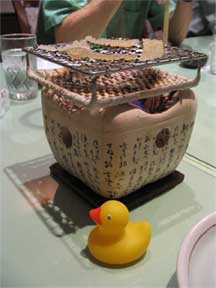First a disclaimer. I am not a coder (any more) or a huge user of photo search software. I have used the on-line Google et. al. image searches that rely on context and tagging, but they don't really compare. Also, I currently work for another division of Hitachi. That's how I got the preview look, but I would have been equally impressed had the software come from anyone else.
The demonstration started with some basic searches. The operator/inventor picked a few images from the internet or his own personal collection (not a part of the indexed collection) and ran a search for similar pictures. It started pretty simple - he chose a picture of an open field and the results instantaneously returned a series of similar photos ranging from remarkably similar to sort of similar to the original. The process was continued with photos of flowers and other such inanimate objects.
Then, once we all understood the basic concept, we moved on to faces. The inventor/operator chose a non-famous person from a news article, and the software instantaneously returned a set of portraits. Note that he didn't specify that the image was a face - the software figured it out. The odd thing was that we humans in the room instantly noticed how similar the faces were - even if we couldn't really articulate what was similar about them. The search image was an Asian woman, and one of the results (down in the second group), was an image of a young Elvis Presley. That seemed an odd result at first, but upon further review we agreed that the composition of the images was such that they did indeed appear similar.
More impressive still was when the inventor/operator chose a promotional poster for "Pirates of the Caribbean" as his source photo. The results instantly came up with not only pictures of each of the actors on the poster, but also with images of cast interviews that had the poster in the background. Again, the operator/inventor hadn't designated or highlighted the faces in any way. The software figured it all out.
The image search was even more mind-blowing when applied to video. The operator/inventor could pick a photo of Condoleeza Rice and the search engine would immediately find video clips that featured her.
As explained to me, this software was not designed to be a replacement for something like Google Image Search. In the Hitachi version, the images and video clips are collected and tagged in a database. The tricks are in the way that the image information is coded and stored, then searched and retrieved. It is not only very accurate, but also very fast. As it was explained, this software was intended to be used in Enterprise applications, and it's not hard to come up with some interesting uses (security, journalism, multimedia production, etc.).
 Personally, I would love to have a copy to run on my personal photo collection. Want to find all pictures of my kids? Start with their school picture and ... boom! Want to find all of the pictures that I've taken of the Eiffel Tower? Blip ... there they are. How about all pictures that include yellow rubber ducks? Bang ... all 12,000 of them.
Personally, I would love to have a copy to run on my personal photo collection. Want to find all pictures of my kids? Start with their school picture and ... boom! Want to find all of the pictures that I've taken of the Eiffel Tower? Blip ... there they are. How about all pictures that include yellow rubber ducks? Bang ... all 12,000 of them. Very cool. And you should have seen the other demonstrations ... but I'll wait for those public announcements first.
No comments:
Post a Comment